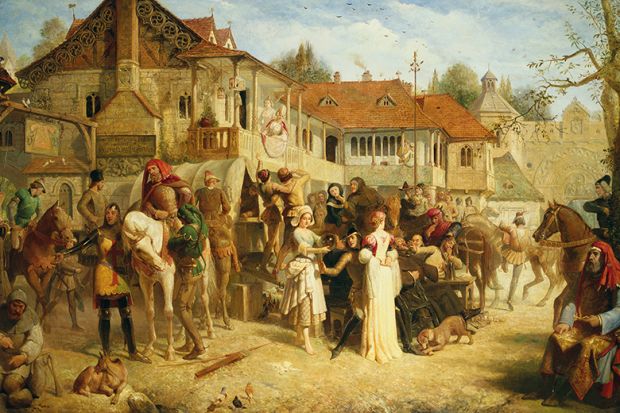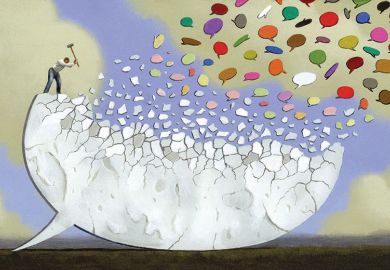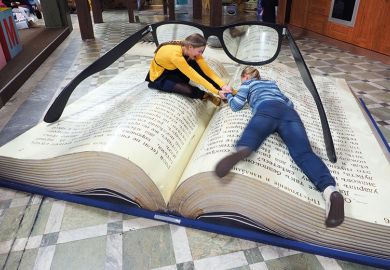Academics’ decisions about the texts that feature on modules and courses shape what students learn and how they understand their subject.
But are teaching staff making the right choices? And are reading lists changing to keep up with evolving scholarly views and fundamental changes in society? For the first time, a project offers a glimpse into what is being taught in universities, bringing together data from 6 million course syllabuses from 80 countries around the world.
The Open Syllabus Project, an interactive map of international curricula, was created by researchers at Columbia University’s public policy institute, the American Assembly. Started three years ago but relaunched last month, the database was built by scraping content from publicly accessible university websites, and using submissions from academics.
Joe Karaganis, vice-president of the American Assembly, said that the project was initially interested in changes in the academic canon, particularly in literature, where what is classed as a “core text” has been a running battle for decades.
“Quickly we realised the data could allow for so much more,” he said. An interactive “galaxy map”, which creates a visual map of disciplines and their most popular set texts, shows the intersections between fields and the relationships between whole bodies of knowledge, Dr Karaganis said.
“It also has all sorts of practical applications at the university: librarians can use it for catalogue management, faculty can use it for course building and administrators can use it to look at what’s happening across the whole university,” he said.
In future, the data could even be used to measure the influence that academics’ work has had in lecture halls around the world – just as citations and other metrics are used to track research impact. “Version 2.0” of the Open Syllabus Project assigns a score of 1 to 100 to each text, to represent its “influence” in classrooms.
Dr Karaganis’ main hope, however, is that academics begin to unpack the stories within the data. “It’s begun to look like a skeleton key to the whole teaching enterprise,” he said.
The project has already yielded some secrets, albeit with results that may seem depressing, and perhaps unsurprising. In terms of tracking scholarly canons, the initial aim of the project, these remain overwhelmingly dominated by white, male authors – often, particularly in the case of the humanities, from the distant past.
Most frequently assigned authors on global syllabuses
| Author | Titles | Appearances |
| William Shakespeare | 791 | 48,282 |
| Plato | 214 | 27,563 |
| Diana Hacker | 13 | 25,571 |
| Aristotle | 150 | 22,054 |
| Michel Foucault | 126 | 16,893 |
| Karl Marx | 165 | 16,607 |
| James Stewart | 33 | 15,031 |
| Elaine Nicpon Marieb | 21 | 14,719 |
| Margaret Lial | 48 | 13,292 |
| John Stuart Mill | 84 | 13,030 |
Source: Open Syllabus Project
In English literature, the most set texts globally include The Canterbury Tales by Geoffrey Chaucer, Paradise Lost by John Milton, and Heart of Darkness by Joseph Conrad. Women do feature, but much less frequently – and not necessarily consistently, either. For example, in 1995, the top 10 included two novels each by Charlotte Brontë and Jane Austen, whereas in 2017 the women in the top 10 had all written instructive books on writing, with the exception of Mary Shelley’s Frankenstein. This appears to reflect a broader recent trend to set more instructive books in English studies, such as Diana Hacker’s A Writer’s Reference.
The most popular texts in history tell a similar story of white, male dominance. In the UK, Linda Colley, a Princeton University professor, is the only woman to make the top 10, with Britons: Forging the Nation, 1707-1837. In the US, Kate Turabian’s A Manual for Writers of Term Papers, Theses, and Dissertations is the only title written by a woman in the top 10.
Meera Sabaratnam, senior lecturer in international relations at SOAS University of London, said that the results were “unsurprising but disappointing in a number of ways”.
“Although we might expect subjects such as history, English literature and political science to offer students a critical, global view, incorporating multiple perspectives on issues, the top 50 titles mostly demonstrate a canon that is distinctly limited in terms of intellectual and ideological perspectives (mostly conservative or liberal), geographical focus (mostly Anglo-American) and the situation of the authors (white, upper middle class and mostly male),” she said.
“Even if we accept that the outcomes of this project are US-centred because of the sampling method, we see a complete erasure of American First Nations peoples from history, politics and literature, a very limited engagement with work written by black Americans and very few from other non-white groups – except where these conform ideologically, such as the work of Francis Fukuyama.”
Dr Sabaratnam said that, “when we talk about decolonising education, if the source material does not reflect a proper diversity of human experience, the education process is failing in a fundamental sense”.
Dr Karaganis did see some hope that, while the scholarly canon may not be entirely revamped, new authors could be added to it: Toni Morrison’s Beloved was the 35th most popular text in English literature this century. “We can demonstrate pretty clearly the arc of adoption of a generation of texts,” he said. The problem is, however, that newer texts appear to come in and then fade away, rather than cementing their place alongside the old canon.
Just as the authors of texts are important, so is their content: and in few fields has the future of a discipline been as hotly debated as economics in the wake of the 2008 financial crash. Economists were widely criticised for failing to predict the disaster, on the whole, and for continuing to focus on the neoclassical paradigm and marginalising alternative perspectives.
Scholars advocating for the consideration of wider perspectives, then, might be disappointed to hear that the works of Greg Mankiw, an adviser to US president George W. Bush and presidential candidate Mitt Romney, have retained four of the top six spots on economics syllabuses since the 1990s.
In political science, a discipline wrestling with the rise of populism around the world, the most common texts are by historical writers such as Thomas Hobbes, Aristotle and John Locke. Other popular set texts were largely written in the 1990s.
When the Open Syllabus Project was first launched, the fact that Karl Marx and Friedrich Engels’ The Communist Manifesto was widely taught in history proved controversial, said Dr Karaganis. “It fed into a variety of right-wing arguments against higher education as part of a process of ‘leftist indoctrination’,” he said. “It’s important to recognise that just because it is set it doesn’t mean endorsement.”
Most frequently assigned titles on global syllabuses
| Title | Author | Appearances |
| William Strunk | The Elements of Style | 11,472 |
| Diana Hacker | A Writer’s Reference | 11,099 |
| James Stewart | Calculus | 8,024 |
| Elaine Nicpon Marieb and Katja Hoehn | Human Anatomy and Physiology | 7,105 |
| Plato | Republic | 7,088 |
| Karl Marx and Friedrich Engels | The Communist Manifesto | 7,057 |
| Diana Hacker | A Pocket Style Manual | 6,976 |
| Mary Shelley | Frankenstein | 6,710 |
| Aristotle | Nicomachean Ethics | 6,591 |
| Thomas Hobbes | Leviathan | 6,052 |
Source: Open Syllabus Project
While many of the authors at the top of the most-set lists are not active academics today, the size of the project’s database – and the introduction of an influence score in the new version – does raise the question of whether it could be used to assess academics and their influence on their discipline.
Dr Karaganis felt that it at least offered a way for academics to gain greater recognition. “Research leaves a very public record. There are many, many tools for understanding the outputs of the research process, but teaching has been much less transparent and much less visible from outside the classroom,” he said.
At the moment, however, the public website of the Open Syllabus Project does not let visitors see which academics set which syllabuses; instead, aggregated information is available.
Nevertheless, some scholars have concerns about how the data could be used. Joe Becker, associate professor of educational leadership at Virginia Commonwealth University, said that he feared the system could lead to less diversity in classroom assignments. “Maybe some more marginalised texts [will] get even more lost because a department decides not to adopt it because it doesn’t have as high a score,” he told EdSurge.
Dr Karaganis, however, said that he hoped the project would make academics realise that they – and their disciplines – had more in common than they previously realised. The “galaxy map” was able to show the intersections between fields and relationships between whole bodies of knowledge “in ways that I think were pretty inaccessible or very hard to visualise”, he said.
The project, which shows the multiple fields any text is set in, could even help newer, more interdisciplinary fields to define themselves by what texts are taught, he added.
Dr Karaganis also argued that the data could be useful for students who transferred between universities, particularly in the US, where this is common; they could use the tool to see how the knowledge they had already acquired could be applied in other disciplines.
The project “represents both the diversity and the integrity of the project of higher education”, Dr Karaganis said. This could be particularly valuable in a context in which degree courses are “routinely misrepresented or characterised through very narrow political lenses…I just don’t see how you look at that map and say ‘there’s a narrow political agenda here at work in higher education’,” he said.
“One of the problems with higher education is that it doesn’t have too many ways of telling that story, and so one of my biggest ambitions for the project is [to] come up with a new way of doing so.”
POSTSCRIPT:
Print headline: Are reading lists stuck in the past?
Register to continue
Why register?
- Registration is free and only takes a moment
- Once registered, you can read 3 articles a month
- Sign up for our newsletter
Subscribe
Or subscribe for unlimited access to:
- Unlimited access to news, views, insights & reviews
- Digital editions
- Digital access to THE’s university and college rankings analysis
Already registered or a current subscriber?








